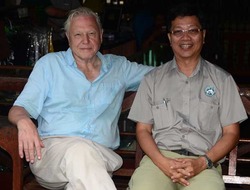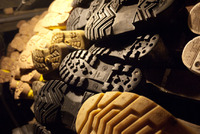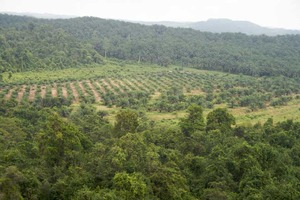Protecting wildlife and fragile ecosystems while boosting livelihoods can be done through purposeful enterprise, as demonstrated by Borneo Eco Tours' Albert Teo, in the Lower Kinabatangan and Kudat areas of Sabah. Mallika Naguran chats with the founder, who's also the Chairman of Borneo Ecotourism Solutions and Technologies, to understand his sustainable tourism business model.

Albert Teo (right) meets his hero Sir David Attenborough who has since become a Conservation Fellow at Sukau Rainforest Lodge. Photo: BEST
Sukau, 15 December 2011. Albert Teo Chin Kion is no stranger to the world of eco-tourism. A pioneer in responsible tourism and travel in Sabah since 1991, he has gone on to establishing the award winning Sukau Rainforest Lodge in the Lower Kinabatangan forest in 1995. He has authored several books on eco-tourism, is established as a keynote speaker at numerous conferences, and is an adjunct lecturer at Edith Cowan University in Australia. A committed eco-missionary, he loves sharing what he knows best: Responsible and sustainable tourism.

Broad facade doubles up as a wildlife viewing platform
Teo’s Sukau Rainforest Lodge has become a key nature-based destination in Sabah, visited by travellers worldwide including celebrity naturalist Sir David Attenborough. The lodge does more than just showcase nature and wildlife, says Teo. “Part of a great experience is to ensure that guests have high standard of accommodation and great food to match up with the incredible wildlife experience. Only then can we truly bring the great outdoor experience to Sukau visitors, and bring Sukau to the international stage of wildlife tourism and ecotourism,” he says.
Minimising Environmental Impacts
Sukau Rainforest Ecolodge is situated on the floodplains of the Lower Kinabatangan forest, a second generation forest that has sprung to life again after previous agricultural use. Recognising its rich biodiversity, Teo determined to leave as little impact as possible while building a 20-room lodge fashioned on a traditional Sabahian longhouse - while stimulating income for the people living in that area. The timber was sourced from local sustainable sources - much of it driftwood - and local skills were harnessed from people like retired fishermen.

Electric boats are docked under the stilted restaurant
The lodge was built away from the riverside to prevent sedimentation of the waterways during construction. It employs an ingenious raised platform on stilts to connect from the riverside. Stilts allow for wild creatures to roam freely under the lodge, not just around it, and do not jeapordise the property during flooding seasons. This allows the dining lounge to be perched over the river, connected to the lounge lobby about 50m away inland.

Wide deck spaces in which to chill, reflect or write a poem
In 2011 Teo completed eco-sensitive renovations to guestrooms and added a newly built communal area (Gomantong Hall). The new facility collects rainwater for gardening and lavatory flush. Passive design to allow for natural lighting and ventilation, and solar-powered showers plus reused cooking oil for lanterns at night cut energy utilisation.

Passive design to allow natural lighting reduces need for electric lamps
“This (improvement) effort will not end,” says Teo. “It is a continuing process particularly now that Sukau is becoming an international ecotourism destination. Unless we begin to implement guidelines for managing tourists on the narrow waterway, we will increasingly see the negative impact of tourism on the experience,” he adds. “We will just love our destination to death if we are not careful!”
Sustainable Ecotourism
I visited Sukau Rainforest Lodge and spent time with Teo last December. During my stay, I was fortunate enough to be taken into the wild accompanied by expert guides who tolerated my never-ending questions on the brilliant local of flora and fauna. Three days in the thick of the wilderness were exciting enough; couple that with long talks with Teo about the challenges of eco-tourism made my visit really special.

Orang utans' survival continues to be a threat in Borneo, but they can be seen alive and well around Sukau Rainforest Ecolodge. Photo: BEST
On my return to Sandakan by boat along the 560km long Kinabatangan River (Sabah’s longest river), I was fortunate to see baby salt water crocodiles, graceful intermediate egrets swooping low for fish, and a peregrine falcon chasing wrinkled lip bats. It’s a wonderful place.
Many tourist destinations take an easier and faster route to running a hospitality business - and ignore its environmental impacts. Embracing the principles of eco-tourism can mean a harder route, at least in the short term, and slower progress. But eco-tourism can bring rewards to both operator and visitor both in the short and long term. Short term through the generation of income and community goodwill, and long term, the conservation of nature and its occupants, animals and plants.

The rhinocerous hornbill with upturned casque is often heard before it is seen
Taking the slower, more rewarding route was what Teo did when he built the Sukau lodge in the far eastern and remotest part of Sabah. He chose the Lower Kinabatangan area where eight species of the hornbill can be spotted and where Borneo’s pygmy elephants roam freely.
Rather than block the elephants’ foraging paths, Teo built a half-km long Hornbill Boardwalk to serve as an observatory. This means elephants can get close to the lodge premises (for the benefit of nature lovers), and in pass through purpose-built gaps.

The nocturnal buffy fish owl will not blink to your lens shutter, but please don't get too close to disturb animals at rest
So now, visitors that wake early morning and decide to go for a boardwalk past the back of the lodge are often rewarded by sightings of a family of pygmy elephants, tearing down branches of leaves as they go by with their swishing trunks. Having the boardwalk to watch from is useful in other ways: these aren’t domesticated, gentle creatures you can pat on the bristly back or scratch behind the elephantine ears. They can and will charge if confronted or provoked so the raised boardwalk offers human safety and protection against these wild animals.

Sabah's longest river at 560 km meanders through the Kinabatangan floodplain, home to Sabah's richest flora and fauna species that include the threatened orang utan, pygmy elephant, tiger and more
Sukau also promises plenty of primate sightings. There are troupes of the amazing proboscis monkey, the grey leaf monkey, the maroon langur (or red leaf mangur), the tarsier, the slow loris, the omnipresent short- and long-tail macacque. And of course the orang utan, which means the “man of the forest” in the Malay language.
The lodge offers river cruises at dawn, afternoon or at night after a hearty dinner with nature’s wonders on display along the banks. The lodge is a pioneer in electricity powered boats usage. This allows quieter gliding and closer observation of birds and beasts. On just one boat ride alone, I spotted a piped hornbill, a blue ear kingfisher, a black and red broadbill, a broadbill kingfisher, a buffy fish owl and a palm civet cat. Now that’s quite a diversity to digest for just one day.
Different Strokes

Gum boots at Sukau Rainforest Lodge take you to wet, wild and wow places
Sukau Rainforest Lodge differs from other resorts in the vicinity in that it takes the trouble to offer descriptions of nature through posters and books (at the lobby and study area). Guests can consult a handy “walking guide” on what they may see from the Hornbill Boardwalk, with a checklist to tick, and space to scribble personal observations. Maybe a poem, if inspired. This, says Teo, is part of the lodge’s responsibility in providing an interpretive account of nature, an essential component of an eco-tourism operator (according to The International Eco-tourism Society guidelines).
“We wanted to highlight the uniqueness of the mega-biodiversity of this region to the world through promotion, education and interpretation,” he explains. “So that with greater exposure and awareness, destruction of the biodiversity will slow down and conservation effort will speed up.”

Oil palm plantations encroach upon previous little habitats of wildlife even on the secondary Kinabatangan forest, which means threatened species have fewer chances of survival. Photo: BEST
Although business is the prime motive for running any agency or resort, Teo sees the pursuit of profit not as a means in itself. Rather, it is a means to a responsible end, or several ends. “With increasing demand for ecotourism experience, it is hoped that more employment opportunities will come to the local community, and this will encourage the government to protect what is left of the natural environment,” he says.
Sukau Rainforest Lodge stands up against the destruction of natural resources - such as timber logging, pollution, wildlife poaching and excessive land conversion for agriculture - and uses their value as a magnet for tourism. It also opens up new ways for the conservation and restoration of nature through objections to irresponsible acts of development, its tree-planting program, wildlife rehabilitation, supply of fresh water tanks for local communities, and medical projects.
Teo has put in place a mechanism to ensure that the lodge’s environmental causes and initiatives will not run out of steam. A certain percentage of proceeds go to conservation programs carried out by its non-profit arm Borneo Ecotourism Solutions and Technologies. The lodge pledges $1 for each international guest, and sister company, Borneo Eco Tours, gives RM8.00 per tourist. In 2009, this generated RM50,000.00 for conservation.

Not to be fooled by the name, pygmy elephants can grow up to 2.6 m tall. They roam on the Lower Kinabatangan guided by a seasonal migratory pattern to source for food, passing through Sukau Rainforest Lodge's boardwalk undisturbed
Also in 2009, the lodge began collecting a RM20 Voluntary Conservation Levy per guest for the WWF, to enhance conservation on the Kinabatangan River and establish wildlife corridors as oil palm plantations encroach on nature reserves.
Community Development through BEST

Learning an alternative trade, virgin coconut oil processing, helps fight poverty. Photo: BEST
Apart from the lodge’s own green policies and environmental practices, a number of programs had been put in place since 1995 to specifically deal with environmental issues and provide relief to the plight of the poor and needy. A series of charity and welfare programs were devised, and led to the formation of Sukau Ecotourism Research and Development Centre, which has since been renamed to Borneo Ecotourism Solutions and Technologies (or BEST).
Teo’s team has moved on to help create social enterprises to assist with long-term solutions to the poverty cycle. This includes providing training to empower women and youths. Through BEST, Teo and his team help communities skill up in specific trades, embrace new technologies and take on new jobs in Kudat, the northern tip of Sabah.
“My role is to create jobs, especially sustainable employment. When you change lives, that is exciting,” he says, then adds with a laugh, “The women are so enthusiastic… that motivates me,” says Teo.

Bavanggazo Longhouse now operates a sustainable business in cultural tourism. Photo: BEST
From 1996 to 2010, more than RM590,000 has been raised and donated to BEST, with 52% of the funds coming from Sukau Rainforest Lodge, Borneo Backpackers and Borneo Eco Tours (all owned by Teo). This funding, he says, has helped establish training programs for new trades such as virgin coconut oil production, herbal and medicinal gardening, community-based mangrove and firefly cruise ecotourism. “I intend to make the community work self-sustaining,” he says. Donations account for the other 48% of the funding.
Teo tells me that in 2012, he sees even greater momentum. Now that villagers are producing handmade products like natural soaps, it’s just a matter of bringing them to market. Says Teo, “We are awaiting approval from the local council and local entrepreneurs in Matunggong to set up a handicraft and tourism centre by converting a longhouse into a tourism and handicraft centre.” Teo has also helped other tourism ventures run by locals, such as the Bavanggazo Longhouse, also located in Kudat. “They (Bavanggazo) are now self sustaining while we gradually phase out our involvement - other than sending our visitors to stay at the longhouse,” says Teo.

A longhouse woman in Sabah makes a dollar or two from handicrafts. Photo: BEST
Passion for Nature
Why this passion for the environment and community development? Teo explains that in the early years he was inspired by Sir David Attenborough. This spurred him towards a sustainable ecotourism business, in particular the nature-friendly lodge. Fittingly, in 2010, the world-famous naturalist and broadcaster visited Sukau while filming a BBC documentary – and even better agreed to become a Conservation Fellow of Sukau Rainforest Lodge. Teo bristles with pride as he shows me photos of himself and his hero, along with beloved creatures of the wild, big and small, including elephants.
Never mind I didn’t get to see the pygmy elephants in person. I will just have to go back again, and to savour the greenness and greatness of Sukau.
Photography by SK Suchen
Additional photos courtesy of Albert Teo and BEST
Mallika Naguran of Gaia Discovery was appointed an advisor to Borneo Ecotourism Solutions & Technologies in 2012.
Links:
Kampung Bavanggazo (Rungus Longhouse)
More about Gomantong Hall at Sukau Rainforest Lodge
WWF Malaysia's Kinabatangan Forest Corridor of Life
Pygmy elephants in Sabah under threat due to fragmented forests
